





















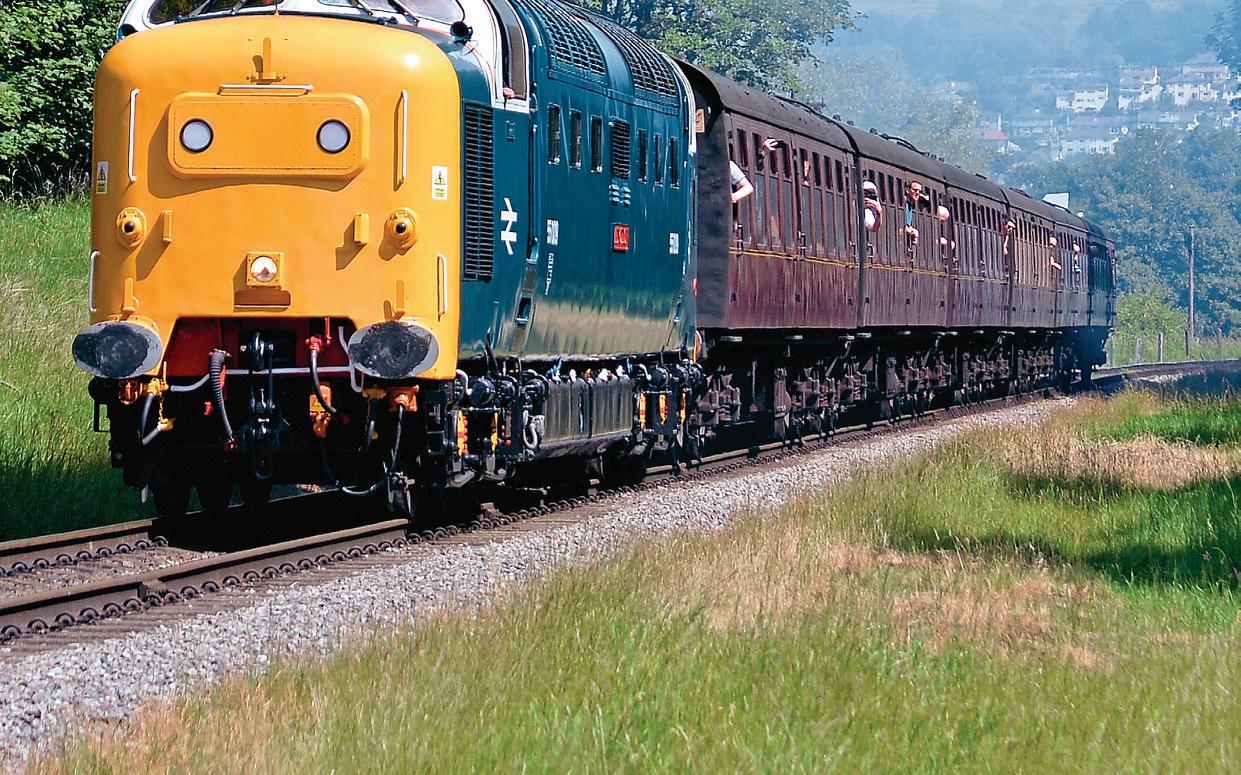







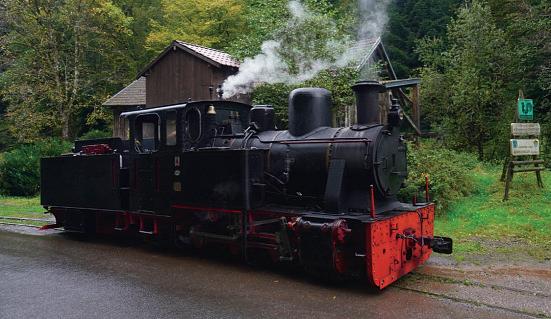
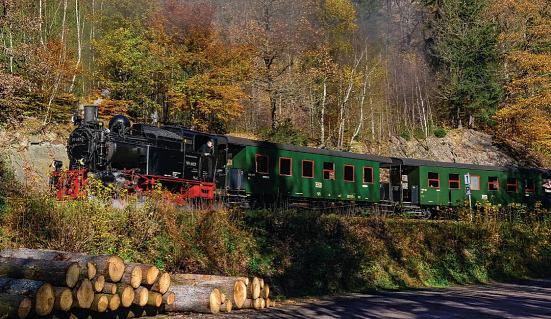
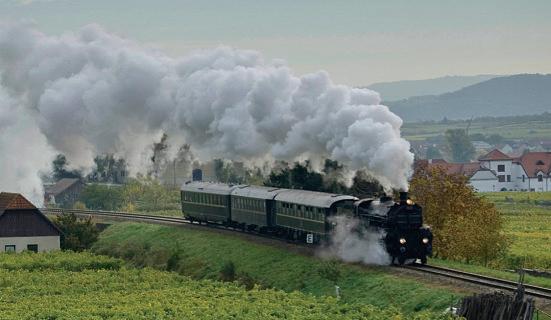

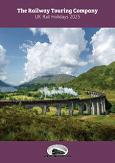
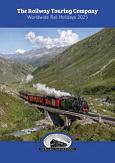












29% OFF

















































29% OFF
July 2025. No.1,492. Vol171. Ajournalofrecordsince1897.
7 Headline News
‘Inspiration’exhibition train launched; Spending Reviewgives money to tram and Metroschemes.
48 Steam News
Keighley-based Standards donatedtorailway.
53 Industrial Steam Middleton acquireshistoricHunslet tank engine
54 Heritage Carriages &Wagons Fresh role forThompson- designedLNER brake.
56 Narrow Gauge
Twolines get answers on extension plans
60 Miniature Sponsors soughtfor railway improvements
61 Heritage Trams Tram plans forNor th Lanarkshiremuseum.
62 Classic Traction
New lifeahead forhistoric prototype railbus in Wales.
66 Railtours
Belmond prepares to launchnew Britishluxur ytrain.
68 Freight
Staff transfer from DB CargotoGBRailfreight
69 Metro Consultants work on Clyde and Tyne schemes.
70 Network New station opens as par tofEast Kilbride upgrade
72 Traction &Stock
Class 730/2s star twork withLondon Nor thwestern.
75 Stock Update
What ’s new,withdrawn, repaintedand named.
77 Operations News
Notable workings from around the countr y.
83 Irish Irish Traction Group locos move to Downpatrick.
85 World
Ex-British HSTsrosteredfor Lagos Red Line duties
24 Subscriptions Offer
Agreat deal and have your magazine delivered,too
41 Readers’Platform &Where is it?
Your letters and our ‘fun only ’pic turequiz.
42 Years Ago
Newsstories from TheRM 100, 50 and 20 years ago.
44 Panorama
Forthe best in railway photography.
87 Meetings
Talks and events in your area of thecountry
87 Reviews
Ourthoughts on twonew railway books.
98 Crossword&NextMonth
Tr yyour hand at ourpopular word puzzle
17 Sir BobReid remembered
Sir BobReid wasBRchairman in the run up to Privatisation. Mike Jones FRSA FCILTlooks back to the 1990s and the challenges faced by this intelligent and empathetic leader who passedawayinMay
18 From Beeching to Sectors
In Part 7ofour series covering the past 200 years of railway histor y, Mike Jones FRSA FCILTlooks at the British RailwaysBoard erafromthe 1960s to 1990s
26 Practice&Per formance
Next month’s ‘Greatest Gathering’event in Derbywill be ahighlightofthe Railway 200 year.John Heaton FCILTpicks out some of the morenotewor thy exhibits and explains whatmakes them special
34 Preserving the first of the‘PEPs’
Ryan Hall describes the work of the400 Series Preser vationGroup in saving EMU No.313201.
36 Thesparkthatlit the flame 2
We presenta fur ther selection of your first railway memories to mark theRailway 200 anniversar yyear
96 TheLong View:July
Celebrating the Railway 200 year with photographs from TheRailway Magazine’s archive.












Produc tion editor: SarahWilkinson
Designer: TimPipes
Editorial assistant: Jane Skayman
Publisher: TimHar tley
Sales and distribution manager: Carl Smith
Head of Marketing: CharlottePark
Commercial direc tor: Nigel Hole
Publishing direc tor: Dan Savage
Published by: KelseyMedia Ltd, Media Centre,Mor tonWay,Horncastle,LincsLN9 6JR Tel: 01507 529529 Fax: 01507 371066
Email: railway@mor tons.co.uk
ADVERTISING
Group adver tising manager: SueKeily
Advertising: Andy Bruce abruce@mor tons.co.uk Tel: 01507 529455
By post: TheRailway Magazine adver tising, Kelsey Media, Media Centre,Mor tonWay, Horncastle,Lincs LN9 6JR
SUBSCRIP TIO NS
Full subscription rates(but see page24for offer): (12 months,12issues,including post and packing) £66 for the UK.Expor trates arealso available,see page 24 for more details.UKsubscriptions arezero-ratedfor the purposes of Value AddedTax.
Enquiries: subscriptions@mor tons.co.uk
CUSTOMER SERVICES
General Queries &Back Issues 01507 529529
Monday-Friday: 8.30am-5pm Answerphone 24hr help@classicmagazines.co.uk www.classicmagazines.co.uk
Archiveenquiries
Jane Skayman 01507529423 jskayman@mor tons.co.uk
Printed by: William Gibbons &Sons Ltd. Magazine &Catalogue Printer, 26 Planetar yRoad, Willenhall,West Midlands,WV13 3XB
Distribution by: Seymour Distribution Ltd, 2Poultr yAvenue,London,EC1A 9PU Enquiries Line: 0207 429 4000
EDITORIAL CONTRIBUTIONS
Accepted photographs and ar ticles will be paid for upon publication. Items we cannot use will be returned if accompanied by astampedaddressed envelope,and recorded deliver ymust clearly state so and enclose sufficientpostage.Incommon with prac ticeonother rail periodicals,all material is sent or returned at the contributor ’s ownriskand neither TheRailway Magazine,the editor,the staffnor Kelsey Media Ltdcan be held responsible for loss or damage, howsoever caused.The opinions expressed in TheRM arenot necessarily thoseofthe editor or staff.This periodicalmust not,without the written consentof the publisher first being given, be lent, sold,hired out or other wisedisposed of in amutilatedcondition or,in anyunauthorised coverbyway of trade or annexedto or as par tofany publication or adver tising,literary or pic torial matter whatsoever
HOWTOSUBMIT PHOTOGRAPHS
Please email high-resolution digital images in jpg/jpeg or tiff formattormpix@mor tons.co.uk Send only unprocessed and ‘straightfromthe camera’ images,and include basic details of ‘what, whereand when’plus the photographer ’s name in theimage’s file name.Ifpossible,embed afull description in the image’s ‘File Info’sec tion.
CDs or memor ysticks can also be accepted by post
This issue waspublished on July 2, 2025.
Thenextissue will be on sale on August 6, 2025. ©Kelsey Media ISSN0033-8923
ASweheadintothe peak summer months,weare also reaching themainseriesof eventscelebrating theRailway 200 anniversary year,with the‘Inspiration’ travelling exhibitiontrain setting off on its12-month journeyaroundthe countr yinJuly, thethree-day ‘Greatest Gathering’ event in Derbyscheduled forAugust1-3, andthe keyStockton & Darlington Railwayeventstofollowin September
‘Inspiration’(seepage7)isaspecial three-coach trainthatisdue to pitch up atmorethan60locations to showcase thepast, presentand future of ourrailways. It features converted Mk.3 carriages with displays curated by theNationalRailway Museum and supportedby moneyfromthe National Lotter yHeritageFund. It wasdue to be launched at Paddington at the endofJunebeforetakingupits first residenceatthe Severn Valley Railway. Butfear notifthatisalongway from whereyou live,asitisbound to come somewherenearbyduringthe year-long programme.
The‘Greatest Gathering’ at Alstom’s factor yinDerby (pages 16 and26-31) should live up to itstitle andhypewith more than 80 locomotivesand units nowplanned to be there, including















steam, diesel andelectricfromacross theages. Despitealarge dailycapacity over itsthree days,tickets to theevent sold outwithinweeks of goingon sale at theend of Januar y. Forthose luckyenough to hold oneofthe prized tickets, it promises to be thebest event of itskindindecades,ifnot all time. The RM will have astand there, however, andwewillhavefullcoverage afterwards forthose unable to attend.
Finally, theS&DR200programme will reachits peak on theactual200th anniversar yofthe line’s opening back on September27, 1825 –including a re-creationofthe firsttrain usingthe National RailwayMuseum’s replica Locomotion No.1.But therewillbe multipleother eventstakingplace either side of this date at Hopetown museum in Darlington,Locomotion in Shildon, andother locationsalong theroute from Bishop Auckland to Stockton (page16).
Much to look forwardtothen, andall of it to be coveredby The RailwayMagazine –itselfjusta young ‘whippersnapper’in comparison,ata mere 128 yearsold













































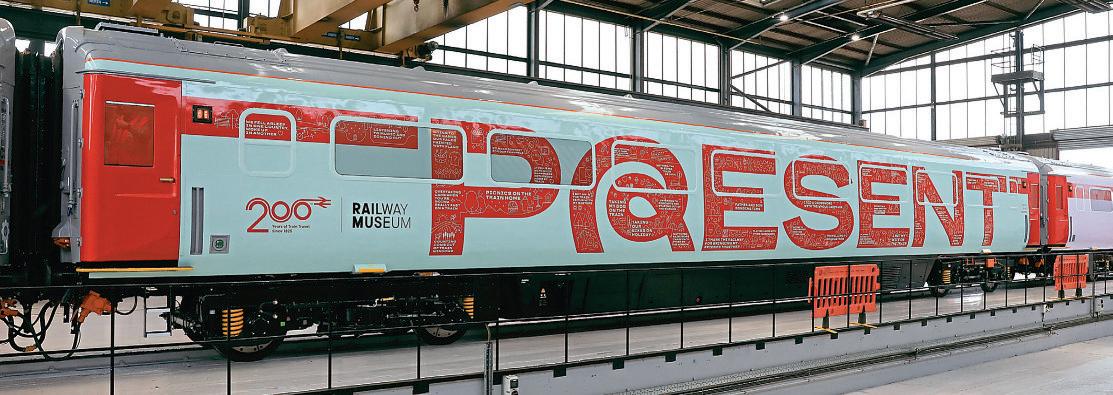
More than 200,000 visitors expectedto visit ‘Inspiration’overits 12-month tour.
BOOKINGS arenow open for‘Inspiration’, Network Rail’s Railway 200 exhibition train thatwill tour the countryover the next 12 months.Itwas due to be launched at Paddington on June 26 beforemoving to the Severn Valley Railway for its first public appearancethe following day.
Theloco-hauled train comprisesthree specially adapted Mk.3 carriages acquired from Hanson &Hall, and an ex-’Nightstar’generator van. Thetrain showcases the past,presentand futureof rail in partnership with the National Railway Museum and supportedby£250,000 from the National LotteryHeritage Fund Theconversion work has been done at LoraminDerby No passengers will be carried
on the train between locations, but it is sheduled to be open to the public at morethan 60 locations across the country.
Afterleavingthe SVR on July 6, the train is due to visit Birmingham Moor Street (July 8-10), Euston (July 12-15), Waterloo (July 18/19), Margate (July 20/21), the Bluebell Railway (July 23-29), and the Greatest Gathering Derby (August 1-3). Other keydates includeFreightliner Doncaster Railport(August 16/17), the NationalRailway Museum York (August 23-31), Darlington station (September 10-17)and Locomotion Shildon.
More than 200,000 visitors areexpectedoverthe year-long tour,and formoreinformation see the websiteatwww railway200.co.uk/inspiration.



TheNationalisation of South WesternRailway givesaninsight into the challenges faced by a Government-run railway
By ‘IndustryUpdate’
PRIVAT Esectoroperation of South Western Railway by FirstMTR ended in the early hours of May25, when the Depar tmentfor Transpor tTrain Operator (DFTO) assumed control, adding the company to the por tfolio of LNER, Southeastern, Nor thern, and TransPennine Express that were previouslytaken over As the first former franchise to be nationalised as aresult of Governmentpolic ynot to renew contractsasthey expire, it is acoincidencethatthe first scheduled train at the star t of Privatisation in the 1990s wasoperated by Stagecoachowned South West Trains on Februar y4,1996 as par tofthe same South Western franchise. Theinitial subsidy paid in 1996/7 was£62.8 million, which wastoreduceto £34.1 million by the end of theseven-year contract.By 2015/16, however, Stagecoach waspaying apremium paymentof£481 million, the highest on the national network
Until GreatBritish Railwaysis established,agrowing number of trainoperators will be managed by the Government using the DFTOteam, but this represents an ongoing challenge as the previously privately-owned structures are displaced.
Threefur ther former
franchises aredue to come under the controlofthe DFTO this year,with c2c first on July 20, followedby GreaterAnglia on October 12 and West Midlands Trains at an unspecified date in December.
The2026 list star ts with Chiltern in March, Govia Thameslink in June,Great Western Railway in September and East Midlands Railway in December.Finally,AvantiWest Coast will be taken over in March2027 and CrossCountr y in June 2027.
In absorbing SWR, the DFTOhas anumber of service deliver yissuestodeal with, not least the slowentry to ser viceof the Class 701 ‘Arterio’ EMU fleet,and thus the need to retain oldervehicles with higher maintenance costs.The delayhas beenthe result of a long industrial disputeabout driver-only operation, which appears to have beenresolved with adecision earlierthis year thatguards will close doors at stations but drivers will open them.
However, it is understood thatClass 701 driver training has been limited because most have been needed to operate the timetabledser vice.The Depar tmentfor Transpor tnow has controloveroperational aspects such as driver recruitment, which it nowhas to address giventhe added responsibilityfor delivering the service.

As GBR is mobilised, investmentinnew rolling stock is likely to be cur tailed giventhe competition for Governmentfunds across all depar tments,inpar ticular defenceand health, although this is eased by the continuing presenceofrolling stock leasing companies and their readiness to buy rolling stock forlease to the train operators Such transactions will requireGovernmentapproval in the future, but one problem isthatfleet expansion to meet increased demand does not necessarily improvethe financial bottom line in the shor t-term, which could mean moreTreasur yfunding is required
This is reflectedinchanges to theproposed objectives forGBR as,inthe 1993 RailwaysAct thatestablished Privatisation, the rail regulator had adutytopromotethe use of the railway to the
THE Chancellor confirmed
£10.2 billion of funding forrail enhancementprojects as part of the Spending Review(SR)
Included in the sum are £3.5 billion forthe ongoing Transpennine RouteUpgrade between Manchester, Huddersfield,Leeds andYork, and £2.5 billion to continue deliveryofEast West Rail, which will ultimately restore adirectrail connection between Oxford and Cambridge.
£240 million has been allocatedtoplans to improve capacityand relievecongestion at Leeds station. Money will also be allocatedfor the
Midlands Rail Hub, ascheme to improverailconnections, servicefrequencyand journey times across the region.
TheGovernmentsays it is committed to at least £445 million of funding for rail enhancements in Wales through theSRand its 10-year InfrastructurePlan.The SRwill provide £300 million towards fivenew stations in South Wales andimprovements to level crossings in North Wales, Padeswood Sidings on the Wrexham-Bidston line and Cardiff West Junction.
Rachel Reeves announced £2.2 billion over four years (2026-30) forTransportfor
London. Andy Lord,London’s TransportCommissioner,said the settlementwould allow a“programme of sustainable development”,enabling TfL to completethe introduction of the new Piccadilly line fleet (nowscheduled to be introduced in the second half of 2026) andnew trainsfor the Docklands LightRailway, as well as newsignalling for40% of the Tube network.MrLord added thatTfL would proceed with its plans to procure new vehicles forthe London Trams system andcould now“progress discussions” regarding apotentialorder for new Bakerloo line trains
greatest extent considered economically practical and also to promotecompetition. The new objectivefor GBR is more ambiguous,simply requiring it to make the best use of the network.
Adecision has been taken thatNetwork Rail will not be dissolved as acorporate entityunder GBR, but will in effecttakeoverthe train operators from the DfTwithin an organisation givenGBR branding.Thereare two reasons forthis,the first of which reflects the need fora continuation of the contractual relationships with the suppliers of infrastructureser vices to NR, but also to have aseamless transfer of staff to the new organisation without changes to the terms and conditions of employment.
An initial task will be the harmonisation of employee terms and conditions from the inherited train operating companies.Trade unions will seek to level up anydisparity in payrates likeinthe British Rail era, whenthere wasastandard rate of payand associated terms and conditions forstaff throughout the network.It is estimatedthatGBR will be responsible foraround 70% of all train operations,given the decision to maintain devolved responsibilities forrailser vices in Scotland,Wales,London and the Liverpool CityRegion. Faresand ticketing will also need to be looked at, but Nationalisation will not necessarily result in lower fares.Previous suggestions by politicians thatlower fares will be one of the benefits wasbased on the removalof privateoperators taking profits But the answer to aquestionat the launch eventmade it clear this is not on the agenda and
could only be meaningfully delivered if the next annual farechange of controlled prices adopts an increase below the retail prices index(RPI) figure and thus below thelevel of inflation.
Theconsultation paper that has been published to refine the make-up of GBR suggests that afur ther devolution of powers to specify and operaterail ser viceswilltakeplace, such as in GreaterManchester and other combined authorities To date,the approach by local authorities has been to tender operations to third-par ty operators,sothis maywell be afur ther dilution of futureGBR responsibility.
Open access passenger operations willalsoexpand, with FirstGroup and Arriva negotiating longer track access agreements to enablethem to acquirenew rolling stock, with fur ther decisions in the pipeline forpossible additional ser vices
Thereisaninteresting por tent forthe futurewith DfT backing foranew Wrexham Shropshireand Midlands Railway,replacing the former Wrexham Shropshireand Marylebone Railwaythat ceased operations in 2011. The new proposal,which is backed by rolling stock manufacturer Alstom, will operate to Euston to speed up journey times and makeitmorecompetitivethan its forerunner.
Theproposal has allowed the expensiveprojection of Avanti West Coast ser vices beyond Wolverhampton to be discontinued,but has yetto receiveregulatory approval givenNetwork Rail objections about the potential impacton per formance.

Thefirst twoof30Class 99 bi-mode Co-Colocos forGBRf arrived at the Port of Bristol, Portbur y, on June 10.Nos 99001 and 99002 were taken to their purpose -built depot on the UKRL siteatLeicester on June 17, wherethey arepictured afterarriving behind No.66307. Main line testing wasdue to beginon June 24, with entr ytoser vice expectedbythe end of the year and full fleet deliver y by the end of 2026. Thelocos provide 8270hp using 25kV AC overhead power, and 2400hp from aCummins QSK50diesel engine.
RICHARD GENNIS
and newTyne &Wear and West Midlands Metroroutes areamong the schemes which areset to go ahead.
By Graeme Pickering
AWEEK beforefull details of the Government’s2025 Spending Review were presented to ParliamentonJune 11, Chancellor Rachel Reeves revealed it would include £15.6 billion fortransportprojects in English CityRegions
At least athirdofthis funding appears to be destined fortram, Metroand other rail schemes. It will be shared between nine mayoralauthorities in the form of five-year financial settlements beginning in 2027,although money has been broughtforward into the currentand 2026-27 financial years to enable preparation and earlier deliveryofprojects West YorkshireCombined Authoritywill receive£2.1 billion to enable it to start construction of its Mass Transit system. Twotramroutes,a Leeds line (running from St James’s UniversityHospital via the citycentretothe White Rose Shopping Centre)and aBradfordline (connecting Bradfordand Leeds citycentres) areplanned forthe first phase. An eight-mile extension of the Tyne &Wear Metrosystem, which will head south from the currentnetwork at Pelawand run via Washington to rejoin it at South Hylton, is expected to cost around £900 million.
Thebulk of thiswillcome from £1.8 billion awarded by the Governmenttothe NorthEast Combined Authority,although NECAexpectsthatprivate sectorfundingwillalso help towardsthe total
TheWest Midlands Metro system will be extended to serve anew Sports Quarter in Birmingham which will include a60,000 seatstadium forBirmingham City Football Club.The estimated cost of £400 million will be sourced from atotal of £2.4billion of Transportfor CityRegions funding allocatedtoWest Midlands Combined Authority. Theextension could ultimately continue to Arden Crossvia North Solihull,Birmingham Airport, the NationalExhibition Centre and HS2’sInterchange station.
GreaterManchesterwill receiveatotal of £2.5billion. Key projects inthe area include the construction of anew Metrolink routeintoStockport town centre,new tram train services to connectOldham, Rochdale,Heywood and Bury, and new Metrolink stops in NorthManchester, Buryand Oldham.
East Midlands Combined Authoritywillreceive£2billion to develop plans foramass transit system linking Derby and Nottingham.Aspartof
plans foramoreintegrated transportsystemproviding betterconnectivity, it also aims to improverail,roadand bus connections throughout the corridor between the twocities.
£530 million from South Yorkshire’s£1.5 billion settlementisexpectedto be used fornew trams,the modernisation of tram stops and reliabilityimprovements on theSupertram system.
Funding forthe Liverpool CityRegion will total £1.6 billion. Theauthorityplans to makeprogress with new stations at Carr Mill, Woodchurch and Daresbury.
Rail,lightrail and trams areamong the options being considered by West of England MayoralCombined Authority
foramass transit network linking Bath, Bristol,South Gloucestershireand North Somerset,for which it will develop plans using £200 million of its funding allocation. Afurther £150 million is earmarked forrail infrastructure improvements,supporting the increased frequencyoftrains Tees Valley Combined Authorityisexpectedtouse £60 million of its £1 billion total forthe construction of athird platform at Middlesbrough station and will also draw upon some of the funding foranew station between Thornabyand Middlesbrough serving the Teesside Park retail development.
■ In aseparateannouncement on June 18, TransportSecretary
HeidiAlexander announced a ‘reset’ofthe HS2 construction plan thataims to correct “historic mishandling”thathas “cost the taxpayerbillions more than planned”.
Greaterministerial oversight will be applied to allow better cost control, andthis includes appointing former Commissioner of Transport forLondon Mike Brownas HS2 Ltd’schairman to work alongside its chief executive officer Mark Wild to deliver a programme reset,including reviewing the costs and schedule
In effect, thismeans the highspeed line is not expectedtobe finished by the currentdateof 2033, with sourcesnow citing 2035 or laterasmorelikely.

Governmentfunding should see Leeds and Bradfordfinally gain amasstransit tram system.
Completed landslip repairs will seethe full routebetween Kidderminster and Bridgnor th reopen on July25.
FULLLINE services on the Severn Valley Railway are expectedtoreturnonJuly25, with the occasion being marked by celebrity‘A3’ No.60103
Flying Scotsman
The1923-built Gresley Pacific, partofthe National Collection and operated by Northern Steam Operations,isexpected to be paired with the railway’s operational Gresley Teak carriages as partofthe line’s “Swingin’Sixties”weekend,from July 25-27. Threeround trips are planned with the engine each day, including the first full-line tripsincethe major landslip occurred at MorBrook,between Hampton Loade and Bridgnorth, at the end of January.
Thestartofrepair work had to wait forextensive planning permission and insurance paperwork to be completed This wassortedbythe endof May, allowing physical work on repairing the landslip to begin. Contracting firm Construction Marine set about removing the topsoil from the area over the arch, which wasremoved
pendingreplacement, then final approval from Shropshire Council wasgranted to access the work siteoverthe brook, and by June 12 more than 2500 tons of material had been shiftedfromthe site.
Theplan to rebuild the embankmentbegins with installing aconcretefooting, afterwhichCML willcarefully liftinmorethan 100 huge ‘Legato’concreteblocks,each weighing around 2.5 tonnes,to form asolid structure. CML will then backfill the embankment structure, using alternate layers of geogrid matting and importedaggregate,which will tie the new wall into the embankmentitself;thus helping to preventfurther slippage.
“They’ll placelarge L-shaped precast concrete units across the topofthe bridgetoform a strongbase to carrythe track bed,ready forthe reinstatement of the rail itself,” explained SVR projectmanager Antony Bartlam. “Itreallyisaveryclever solution indeed,and CML’s
progress is impressive, helped by the recent good weather.”
Despiteworking on previous rail infrastructureprojects,CML contractsmanager StuartHale explained this scenario wasnot atypical embankmentfailure.
“Weneeded to find arobust and permanentsolution thatwe could build at speedand which wasaffordable to aheritage line. It also needed to comply with the local authority’smitigation measures,working around the watercourse.We’re very glad to nowbeatthe ‘boots-onthe-ground’stage and looking forwardtogettingthis finished, hopefully with no undue problems.”
TheSVR’s managing director Jonathan ‘Gus’Dunster has beenkeen to emphasise the public supportreceived by the railway sincethe incident. “Assoon as the embankment failurehappened at the end of January, we sawatremendous groundswell of supportfrom the public.Thousands of people havedonatedand,together with money from our insurance

By Graeme Pickering
COVENTRY’Sprototype batterypoweredverylightrail (VLR) vehicle completed athreeweek programme of public demonstration runs on June 22. It carriedupto17seated passengers and one wheelchair user during the trials on the specially-constructed 220 metres (240 yards) of line on Queen Victoria Road and Greyfriars Road in the city, but could accommodate up to 56 people in normal service.
Thetype of track used was
designed specifically forthe Coventry projectand sits just 30 centimetres (11.8 inches) into the road surface, avoiding the need to divertutilities and thereforemaking construction less costly than conventional tramways.The vehicle can also negotiate 15mradius curves. Coventry CityCouncil told TheRM thatthe demonstrations had proved the Coventry VLR concept was“working well”. The vehicle will undergo further testing at the Very LightRail National Innovation Centre in Dudley,but is expectedto

‘A3’ No.60103 will reopen the full length of the repaired Severn Valley Railway on July 25. It is picturedona previous visit to theline on September 24, 2016, crossing over the RiverSevernatVictoria Bridge KEITH WILKINSON
company, this has meant we could go ahead with this essential repair work to reunite the whole length of the line to Bridgnorth.
“It’ssosatisfying to nowbe making real progress with this repair.We’ve had alot of frustrating delays,but all of them were necessary. We needed to get clearance for the temporaryculverting of the watercourse forexample, along with ecological surveys to determine the impact of the works on wildlifesuch as otters,
fish and crayfish. We also had to work with National Grid,whose high voltage powerlines run rightacross the middle of the site.”
Until the July 25 full reopening,the line remains in use over the 12 miles between Hampton Loade and Kidderminster.LMS Stanier Mogul No.13268 joined the operational fleet at Bewdley on June 17 afterbeing moved down by road in time for the ‘Trains Through TheAges’ weekend on July 5/6.
: Ashortage ofGBRf traction sawBo’ness and Kinneilbased Type 3No. 37403 Isle of Mull draftedintowork the 1B16 Aberdeen to Edinburgh por tion of the Caledonian Sleeper ‘Highlander’ ser vicetoEuston on June 13, and 15-19(plus the return 1A25Aberdeen por tion on June 14, and16-20). Following asuccessful trial run of thenor thbound working in 2023, theSRPShas acontracttosupply the ‘37’ as required,althoughthe previous last run of a‘ Tractor’ on the southbound run is thoughttobeApril 1, 2008. 1B16 is pictured at Drumlithie (Aberdeenshire) on June 15 with electrodiesel No.73968 dead-in-tow as acoupling translator. CAMERON PTASZEK
come back to the citycentre to run on an 800-metre(875 yards)-long demonstration line in 2027. Information gathered will be used to help progress plans forthe city’sfirst full VLR route, whichislikely to servean investmentzone at Coventry Airport.
Right: TheCoventr yVLR vehicle is seen on June 3during public demonstration runs on the track laid in the citycentre. It wasoperated by staff from Rail Adventureduring the three -week trial










































T: Thereopened EWRroutebetween Bletchleyand Bicester welcomed itsfirst freightser viceonJune16, when No.66090 MaritimeIntermodal Six hauled aMaritimeintermodalser vice over theroutewhile travelling from Southampton to open thenew Strategic Rail FreightInterchange at the SEGROLogistics Park in Nor thampton. Theser vice will run fivedaysa week,the freightuse coming ahead of the planned Chiltern-operated passenger ser vice, which stillawaits a star tdatealmost ayear afterthe line wasofficially opened.(Seealso page 68.)
PHIL MARSH
of options being considered
By Graeme Pickering
TR ANSPORT forWales is considering fur ther expansion of its train fleet.TfW chief executiveJames Pricepointed to year-on-year increases in passengers as areason to examine possibilities for acquiring moreunits.
OfficeofRail and Road
GBRf ‘Tug’No. 60087
Ingleborough backs into Hor ton-in-Ribblesdale quarr ywith the first train to use the newrail connection and sidings off the Settle &Carlisle Line,onJune 17. Stone waspreviously taken by road to the Ribblehead vir tual quarr yfor loading onto trains,but the new rail loading terminal at Hor tonremovesthe need to use lorries on the local roads. IAIN REID
figures published last month showed31.3 million passenger journeysweremade with TfW between April 2024 and March 2025, an increase of19% on the previous 12 months.The number is still belowthatseen in 2018-19, prior to the Covid pandemic,but reflects afairly consistentrise over the last three years.
ATfW spokesman confirmed to TheRM thatitwas “assessing arange of different options forthe procurementof additional units”and thatthis wouldinclude areview of its current rolling stock to work out “how best to manage the potential integration”ofthe extratrains.Hewas unable to elaborateonrepor ts thatitwill extend its lease of Class 153 single -car diesel units in the meantime.
As things stand,TfW is yet

to realise the full potential of trains ordered since2018 as par tofan£800 million procurementprocess.Atthe beginning of the year,MrPrice explained to members of the Senedd thatitwas suffering setbacks as aresult of delays involving manufacturers Stadler and CAF. Daily availabilityofoperational CAFbuilt Class 197s wasaround four units shor tofwhatwas expected.
In awrittenresponse to the
Welsh Parliament’sClimate Change,Environmentand InfrastructureCommittee, datedMay 30, he said TfW wasusing “every possible resource”available to ensure prompt deliver yand hold manufacturers accountablefor the units which areyet to be handed over.Early 2026 is now understood to be the target for European Train ControlSystemfitted Class 197s taking over Cambrian Line ser vices from Class 158s.

BA NK : TheCombe Rail charityhas installed ademonstration 30-foot track panel on Ilfracombe bank,par tofthe former three -mile climbat1-in-36fromIlfracombe to the summitatMor tehoe.The track panel wasdonatedbythe West Somerset Railwayand installed with assistancefromBidefordRailwayHeritage Centre.Combe Rail exists to preser ve the heritage of the much-missed line between Barnstaple and Ilfracombe,which closed on October 5, 1970. COMBE RAIL









Afterrelease by East Midlands Railway,fiveunits will beformed into six-car sets forLumoser vices between Stirling and Euston.
By Graeme Pickering
ALSTOM has secured a £50 million deal to refurbish and maintain fiveClass 222 DMUsfor FirstGroup’s new Lumo servicebetween Stirling and Euston from mid-2026. Configured as fiveand seven-car sets,atotal of 27 Class 222s currently form part of the East Midlands Railway fleet.But these will be displaced by 33 bi-mode Class 810 ‘Aurora’ units being built by Hitachi at its Newton Aycliffefactory in County Durham. Handback of the Class 222s to owner Eversholt Rail is expectedto begin this September
Theunits to be leased to FirstGroup will be formed into six-car sets and receive whatEversholt describes as “extensiveinterior upgrades”, including new seating, improved wi-fi forpassengers,
and CCTV.Anintelligentengine start-stop system (IESS)will be installed,reducing fuel consumption and emissions when stationary. Thetrains will be repaintedintoLumo livery. The£10 million refurbishmentprogramme willbecompleted at Alstom’s Widnes site, whichspecialises intrain modernisation. The contract also includes a £40 million five-year agreement to maintain, overhaul,service and clean the fivesetsat Alstom’s CentralRivers depot in Burton-on-Trent.
West Coast use Lumo launched itsservices between Edinburgh and King’s Cross in October 2021, but thenew routebetween Stirling and Euston willserve Larbert, Greenfaulds,Whifflet, Motherwell,Lockerbie,Carlisle, Preston, Crewe, Nuneaton
BTPfunding
POOLE MP Neil Duncan-Jordan, York
CentralMPRachael Maskell and Sheffield Hallam MP Olivia Blake all wanted to know whatplans the Departmentfor Transporthas forfuture funding arrangements forthe British TransportPolice during and afterthe transition to GreatBritish Railways.
Simon Lightwood,the Parliamentary Under SecretaryofState forLocal Transport, said: “The BTPbudget is set by the British Transport Police Authority. It is the executivenondepartmental public body that oversees the forceand is their employer. BTPA sets the BTP’sbudget annually following proposals from theForce and viewsfromindustry.
“Weanticipate thatthe levelof funding forthe BTPduring the transition to and commencement of GBR will similarly balancethe needs of the industryand the forceagainst public sector affordability.”
DUNSTABLE and LeightonBuzzard
MP AlexMayer asked whatdiscussions the DfThas had with National Grid on resilienceinthe rail sector.
Mr Lightwood replied: “Network Rail,

and Milton Keynes
“This is another important step towardsrolling out Lumo as anationwideoperator and growing our open access capacity,”said FirstGroupchief executiveGraham Sutherland
“Our investmentand capabilities in open access rail have delivered reliable,value for money services,grown rail demand and helped to spur economic growth and connect communities.Welook forward
Compiled by Jon Longman
as the owner and operator of Britain’s railway infrastructure, is responsible for ensuringthe resilienceofthe railway. NR and National Grid areindiscussions about the rail sector’sresilience, including issues relatedtopower supply,climate changeadaptation,and infrastructureimprovements
“These discussionsinvolve stakeholders to ensure acollaborative approachtoaddressing challenges and opportunities to grow,expandand improvethe resilienceofthe network to meet the needs of passengers and freightusers.”
East-West by North
LORD Alton of Liverpool asked what the timeframe is forimprovements to east-west rail links and progress on providing aregularpassenger serviceonthe Hellifield Link between Lancashireand Yorkshire.
TransportMinister Lord Hendry replied: “InMay 2024, Northern Trains launched the YorkshireDales Explorer, whichlinks Manchester and Ribblehead, restoring passengerservicesto the line between Clitheroeand Hellifield for the first time in morethan twodecades Northern has worked with local bus providers to co-ordinate services
to doing the sameonour new services.”
■ Also in June, FirstGroup announced thatithad submitted aformal application to theOffice of Rail and Road to run Lumo services between Herefordand Paddington. If successful,itplans to launch them in December 2027, along with its alreadyapproved trains between Carmarthen and Paddington.
Thecompany proposes
and with stakeholders including the YorkshireDales National Park and rambling groups,who organised walks around the timetable.
“This servicehas been agreat success and wona silver awardinthe tourism categoryatthe 2025 Community Rail Awards.Rail North Partnership and Northern arenow working with stakeholders including Lancashire County Council and York &North YorkshireMayoral Combined Authority to assess whether additional services on this line could be operationally practical and offer value formoney.”
GBR on the way
SOUTH West WiltshireMPDrAndrew Murrison askedwhatsteps GBR plans to taketoimprovethe passenger experienceonthe West of England line
Mr Lightwood replied: “Services operated by South Western Railway, which operated the West of England line,transferred into public ownership when their contract expired on May25. Under public ownership,passenger services will be operated in the interests of passengers,not shareholders “Bringing train operations into public ownership is the firststepinthe Government’splans forwider rail reform.
tworeturn Monday-Saturday journeysand one on Sundays, calling at Bristol Parkwayand Severn TunnelJunction, and providing directLondon services forCwmbran, Pontypool &New Innand Abergavenny.
It would source trains forthe Herefordroute by activating an option to extend its original order for14new ‘800 series’ units from Hitachi, placed last December.
TheRailwaysBillwill be introduced later this session,enablingthe establishment of GBR. GBR will have the tools and operational independenceit needs to plan andrun the rail system on alongterm basis to deliver forpassengers and freightcustomers.”
Crossing request
NORTH ShropshireMPHelen Morgan wantsthe DfTtoask NR to install overlayminiaturestoplights at Viaduct level crossing in Chirk Bank
Mr Lightwood replied: “My departmentlooks to NR, as the infrastructuremanager forBritain’s railways, to makeoperational decisions independentofgovernmentin accordancewith its statutorysafety duties and expertise.Theseinclude decisions on the appropriate safety arrangements at specific levelcrossings, which areinformed by thorough risk assessments.
“These risk assessments consider a range of factors,including potential hazards,visibility, train speed and level crossing usage.Itisimportant thatthese decisions aremade by NR, without anyinterferenceordirection from my department, to maintain its independence.”
THE weekend of June 7/8 sawthe East Deck of HS2’sM6South viaduct moved119 metres (130 yards) over the slip road adjacenttothe motor way. It wasthe first of a three -stage process in which the deck will be movedintoits final position.
Subsequentslides will takethe deck across the M6 and the M6-M42 link roads.After each push the next section of deck is added behind it, meaning thatthe total weightbeing movedwill increase from an initial 1300 tonnes to 3290 by the time of the final slide
Thesecond and third movesofthe doubletrack East Deck,which will carr yLondon-bound trains,are due to be completed laterthis year. TheWest Deck,which will also be double track and carr yBirmingham and other nor thbound trains,will be assembled and movedintoplace next year
Li ke us facebook .com / TeRa ilwayM agaz ine
Follow us
@rai lway ma ga zi ne
Follow us
therai lway ma ga zi ne
Thethree underground islands will be ser vedbyHS2’sfleet of 400 metre-long trains
CONSTRUC TION ofthe six 450 metre-long (492 yards) underground platformsat HS2’sOld Oak Commonstation is under way.
Configured as three islands,they arebeing built simultaneously more than 65 feet belowground in the 850 metre-long (930 yards) station boxwhich wasstructurally completed earlier this year
Theassembly process works inwards, from either end of the boxtothe middle of the platforms.Inver twalls with aheightof1.59 metres (5.2 feet) were createdbypouring concrete. Atotal of 1960 concreteslabs,the largest of which are4x 2metres (13 x6.6 feet) will be placed on topof the walls.The slabsare being made off-sitebythe Laing O’Rourke-owned business Explore Manufacturing at Worksop in Nottinghamshire. Thefinished platforms will have avoid below to carr yser vices including electricity.
“Whilst thereisstill much more to work to do,standing wherepassengerswillalight HS2 ser vices is areminder of what this railway will achieve, creating connections between people and places,thatwill benefit generations to come,” said Huw Edwards, HS2 Ltd’s deliver ydirectorfor stations.

Aprecast concreteslab being loweredintoplacetoform par tofone of the six undergroundplatforms at HS2’sOld Oak Common station. HS2
Theplatforms will be servedby afleet of 54 trainsbeing built for HS2 by Hitachi andAlstom in a jointventure. Eacheight-car set will be 200 metres long,giving atotaltrain length of 400 metres(437 yards) and 16 cars when working in pairs.Onthe sur face, work will begin later this year on building afurther eightplatforms forGreat Western Main Line,Elizabeth line and Heathrow Express services
: Having broken through at the western end of Bromford Tunnel at Washwood Heath, completingits 3.5mile drivefromthe WaterOrton por tal earlier in themonth, astar twas made on dismantling tunnel boring machine Mary Ann on May30. Thethree -month process beganwith the lifting of the 120 tonne cutterheadback to ground level. Thepar ts willbereturned to TBM manufacturerHerrenknecht. HS2

Contractor BBVS JV is already working at groundfloor level, on the sitefor the station superstructure. In the eastern section of the station box, preparations arebeing made forthe launch of twotunnelling machines towardsEuston. From its western side,ashort tunnel,tobebuilt using sprayed concretelining,will connectit with the Victoria Road Crossover Box(with pointwork allowing trainstoswitch lines), which leads to the eastern end of the
8.4 mile-long Northolt Tunnel HS2 LtdsaysOld Oak Common will be one of the best connectedinthe UK,with the potential to reach over 100 stations.Research by Arcadis, commissioned by the company and published earlier this year, claims thatthe projectcould provide alocal economic boost of £10 billionand be acatalyst forthe construction of over 22,000 new homes,693,000 square metres of business space and nearly 19,000 jobs

: Thethirdoffour TBMs to completeits work on Nor tholt Tunnel brokethrough at Green Park Way, Greenford on June 6. Emily had begun excavating the first boreofthe eastern section of tunnel from Victoria RoadCrossoverBox in Nor th Acton during Februar ylast year.The cutterhead,front and middle shield of Caroline,which createdthe second boreofthe western section, were liftedback to the sur face on May25. HS2


Ongoing to Januar y2026
NRM YO RK
‘Railway Firsts’, acollection of well knownand unexpected stories thathaveshaped the railwaysand our histor y.
June 2- earlySeptember
VA RIOUS DATES
Bluebell Railway ‘Education’ (for schools) and ‘Celebration’ (general public) events covering thepast,present and futureofour railways.
June 27-summer 2026
VA RIOUS LO CATIONS
‘Inspiration’travelling exhibition Train. Bookings nowopen to visit the Railway 200 train as it visits more than 60 locations around the countr y. Seerailway200. co.uk/inspiration forhow to book
July11- Oc tober 5
HOPETOW NDARLI NG TO N
‘STEAMtothe Future’, reflecting on the histor yof steam railwaysand howthe rail industr yisgearing up for asecond revolutiondriven by green technologies
August 1-3
ALSTOM DERBY
‘The Greatest Gathering’ Works open days SOLD OUT
September 20-October 5
HOPETOW NDARLI NG TO N ‘Titans of steam’
HO PE TO WN Darlington’s ‘Titans of steam’inautumn will displaysix locomotives with a Nor th East connection.
Theevent from September 20 to October 5will featureBR StandardClass 2No. 78018, ‘K1’ No.62005,‘Q6’ No.63395 ‘J27’ No.65894,‘A4’ No.60007 Sir Nigel Gresley,and new-build ‘A1’ No. 60163 Tornado.
Footplate tours will be available on the ‘K1’,‘A1’, ‘A4’,aswellasworkshop tours of the Darlington LocomotiveWorks (home to TheA1Steam Locomotive Trust), and the 1861 Shed (home to Darlington Railway Preser vation Society and the Nor th East Locomotive Preser vation Group).
Theevent is being delivered by Darlington Borough Council,whose head of heritageand culture Mike Crawshawsaid: “We’re thrilled to bring agathering of legendar ylocomotivesto HopetownDarlingtonwhich offer aglimpse into the historic engineering thattook place

‘J27’ No.65894 will be one of the six ‘Titans of Steam’ at HopetownDarlington this autumn JAMESPEARC Y/NELPG
in Darlington and helped railwaysnot just across the region, but across the countr y, and indeed the world,thrive.”
SteveDavies,chair of the
A1 Steam LocomotiveTrust, added: “Steam wasa catalyst forthe railway revolution, and the ‘Six Titans’showcase the innovation of steam, knowledge and engineering.” Tickets forthe gala are available to book online at hopetowndarlington.co.uk/ titans.
THE National Railway Museum’s celebrity‘A3’ No.60103 Flying Scotsman wasannounced as the latest exhibit forthe sold-out Greatest Gathering eventat Alstom DerbyonAugust 1-3. Theannouncementbrings the tally of confirmed exhibits to morethan 80 as this issue
closed forpress,comprising 18 steam locomotives,38diesels, 11electrics,two DMUsand 12 EMUs.
Thethree-day festival claims to be the world’s largest-ever gathering of historic and modern rolling stock,and forms partofthe wider festivities

TheStockton &Darlington Railway 200 Festival has unveiled a series of nine murals by six ar tists to mark the 200th anniversary of the opening of the S&DR. Thefirst of the newmuralsalong the S&DRTrail of Discover ywereunveiled on June 10, with Kate Jackson’s ‘Motion 200’ at Heighington station (pictured) and Adébayo Bolaji’s ‘Time and Place’ at Darlington station. Allwill be located at keysites along the routeofthe S&DR between Witton Park in County Durham andStocktoninTees Valley. The four other ar tists areMorag Myerscough,CarolineCardus, Lewis Hobson and Aida Wilde GR AEME ROWAT TPHOTOGR APHY
forRailway200, theyearlong celebration marking the opening of the Stockton and Darlington Railway on September 27, 1825.
Thelist as of June 25 wasas follows.
Steam: S&DR Locomotion No.1;FRNo. 20; LNWR No.1054; MR No.1000; LNER Nos.60163 Tornado,60103 Flying Scotsman, No.60007 Sir Nigel Gresley;LMS Nos.13268, 44932, 46115 Scots Guardsman,45699 Galatea, 45596 Bahamas,46203 Princess Margaret Rose;GWR Nos.4930 Hagley Hall,6023 King Edward II; SR Nos.35018 British India Line,35028 Clan Line;BR No.73129.
Diesel: Nos.08721 KenDavies,D8568, D5910, D5054 (24054) Phil Southern,26007, 31108, 33012, D7076, D6700 (37119/350), 37401 MaryQueen of Scots,37401 An Comunn Gaidhealach,37501 Teesside Steelmaster,D213 (40013) Andania,40106 Atlantic Conveyor,D821 Greyhound, 43xxx (RailAdventure), 44004 Great Gable,45118 TheRoyal

Amongst the exhibits available to see at theGreatestGathering will be aROG Class93, the latest of which No.93008 is seen afterdelivery to Portbur yDocks on June 13. NICK VINCENT

Artilleryman,46045, 47593 GallowayPrincess,47715 Rail Engineering Solutions,50033 Glorious,50035 ArkRoyal, 50044 Exeter,50049 Defiance,D1015 Western Champion,D1062 Western Courier,D9000 (55022) RoyalScots Grey,55009 Alycidon, D9015 (55015) Tulyar, 55019 RoyalHighland Fusilier,56301, 57xxx (WCRC), 57307 Lady Penelope, 57313 Scarborough Castle,66501 Spirit of ’65,67005 King’s Messenger, 70008.
Electric: No.12 SarahSiddons, 83012, 85006, 86101 Sir William Stanier FRS,86401, 87002 Royal
Sovereign,90018, 91101 Flying Scotsman,91110 BattleofBritain Memorial Flight,92011, 93xxx (Rail Operations Group).
DMU: Class 108 (51941/52064), 142013, 150235. EMU: Nos.313201, 323221, 331xxx (Northern), 350xxx (LNR), 390119 Progress,3417 Gordon Pettitt, 465908 Chris Green, 507001, 720506, 730xxx (LNR), 755xxx (GA),799201. Therewill also be various narrow gauge and miniature locomotives,a selection of carriages and wagons,a 5-inch gauge demonstration layout, and much more ■ Seealso pages 26-31 formore details on selectedexhibits
Sir Bob Reid, BR’s chairman in the runuptoPrivatisation, passed away on May 28 aged 91. Mike Jones FRSA FCILT looks back to the1990s and thechallenges faced by this intelligent and empathetic leader.
WHENSir Robert Reidretired from beingchairmanof BritishRailin1990, therewas an unexpected continuation as hissuccessor wasnamed as SirBob Reid(andthusknown colloquially as ‘Bob Reid2’).
Thetwo menwerenot related, however, andindeedhad quitedifferent personalities. SirRobertwas acareerrailwayman, whohad joined theLNERasa trafficapprenticeafter military serviceinthe Second WorldWar ; SirBob hadspent acareeratoil firm Shell, latterly as itschief executiveafter managing worldwideexploration
When SirBob joined BR,itwas atimewhen therewas amoreoptimisticfuturefor therail industry followinga switch from regional to sector management,which hadenabled greater investment as aresultofimprovedproductivity andgreater customer focus.
Asystemoperating loss of £985 millionin1982 hadbeenreduced to £349 millionin1989, with theInterCity sector eliminatingalossof£196 milliontodeliver aprofitof£41 million on aturnoverthatincreased from £350 to £572 million. Railfreightalsoimprovedits performance, recordingaprofitof £48million in 1989 afterbarelybreakingevenin1982, although heavyrationalisation of wagonloadservices meantthe turnover wasstaticat£486million
Thestructuralchanges hadnot been withoutcontroversy, however, as previous cross-subsidisation betweendifferent partsof thebusinessthendisappeared –for example, profitsfrommovingcoaltopower stations hadpreviouslybeenusedtofundinvestment elsewhere. Thedrive to make InterCity profitable hadalsoseena concentration on core routes,resulting in thelossof connectivity forsomesmaller cities andtowns
Thepolicyafter 1990 wastoacceleratethe processbybringing functional management, such as civilengineering, undermoredirect controlofthe sector andsub-sector managers, with theultimateaim of abolishing regional generalmanagers.But therewas frustration that alackofGovernment fundingcontinued, whilethe useofwhatinthe future wouldbe called aprivate financeinitiative(PFI) wasthen prohibited by theTreasury.
Channel Tunnel Rail Link routing
On assuming thechairmanshipinOctober 1990,Sir Bobimmediately hadcriticaldecisions to make aboutthe routeofthe Channel Tunnel Rail Link (now called HS1). Given that investment had alreadybeenmadeto
buildWaterlooInternational (opened1994),it seemed that aroute to this terminal wasthe best option,but politicalfactors also entered theequation.
At thetime, thedevelopment of theformer docklandsinEastLondonmeant that a routethrough this area to St Pancraswould be cheaperand less disruptive than building throughestablished residentialareas southof theThames. Thedocklands routewould also stimulateeconomicregeneration.
SirBob adoptedthe stance that theamount of moneyalready invested in theWaterloo routewas such that it wouldbeperverseto change tack,and he lobbiedthe Government accordingly. Acoalition of ministersfinally putpaidtothisplan, anditwas decidedthe routewould rununder theRiver Thames to serveStratford andStPancras (althoughdelays meantthatHS1 didnot fullyopenuntil 2007).
TheHiddenReportintothe ClaphamJunction accident of December 1988 identifieda need for acomprehensiveimprovement in railwaysafety,
“Behindthe scenes, SirBob andthe BR Boardwere unenthusiastic aboutthe formation of Railtrack”
whichwas underlined by subsequent accidents at Purley andBellgrove (Glasgow)onMarch 4 and6,1989.
TheBRBoard’s response wasthatanannual safety plan wouldbepublished,which was firstreleasedinFebruary1991, by whichtime SirBob hadassumed direct responsibility foritand implemented apolicyofabsolute safety that reflectedhis experience in the oilindustry. We stillsee thebenefitsofthis today, as everyorganisationconcerned with railwayoperationsmusthaveanapproved safety management system before aregulatory licenceisobtained, andthisisSir Bob’s continuing legacy to us
Privatisation doubts
TheConservativeGovernment of the late-1980s/early 1990shad promoted the







privatisationofmanyofthe nationalised industries,and didnot seewhy BritishRail should notbeone of them.SowhenJohn Major(laterSir John)secured an unexpected parliamentarymajorityinthe 1992 General Election,railway privatisationwas to follow Anumberindustries, such as BritishGas, hadsimplybeenchanged from beinga public corporationtoapubliclimited company, but this hadnot been showntochangewhat wasseenasbureaucraticbehaviour anda dismissive attitude towardscustomers.For that reason,lobbyingbyBritish Rail to simply maintain thestatusquo by creating a‘British Rail plc’ foundlittlepolitical support.
Thecontentsofthe Railways Act, which received RoyalAssentonNovember5,1993, didnot specify in detail howthe industry’s structurewould change otherthantomake provisionfor thefranchising of passenger services anda future policy of open access to thenetwork
Open access followed forfreight,parcels and charteroperations, butthe passengermarket wastobeinitially constrainedbywhatwas describedas‘amoderationofcompetition’, whichineffectinitially blockednew operators from runningservices.
Behind thescenes, SirBob andthe BR Boardwereunenthusiasticabout the formationofRailtrack (the predecessorof NetworkRail) as ownerofrailinfrastructure, separate to operations,asitbelievedan integrated railwayshouldberetained. These viewswererejectedbythe Government and thenew privatised structurewas established in April1994, whichalsosaw tworegulators createdtooversee decision making:the Office of theRailRegulator (ORR)and theOfficeof PassengerRailFranchising (OPRAF).
With theintentionthentodissolvethe BritishRailwaysBoard in itsentirety, SirBob Reidleftthe industry in March1995atthe end of afive-year contract.Hewas well regarded throughout theorganisationasanintelligent andempatheticleader. ■






In Part 7ofour series covering the past 200 years of railway history, Mike Jones FRSA FCILT looks at theBritish Railways Board era from theearly 1960s to themid-1990s.
JANUARY 1963 sawthe BritishTransport Commission woundupand railwayoperationstaken overbythe BritishRailwaysBoard.Its chairman wasDrRichard Beeching,anICI executivewho hadbeenpartof theStedeford Advisory Panelformedafter the1955 ModernisationPlanhad failed to have an impacton rising financiallosses, whichamountedto£159million in 1962 (equivalenttoaround£3billion today)
Theaim of appointing Beeching wastoapply private sector strictures to public sector operations,withthe goal of railwayfinancesreachingbreak-evenwithinfiveyears andensuringthatany investment earneda definedrateof return.Beechinginitiated trafficstudies forbothpassenger andfreight operations,ashebelievedthatdecisions needed astronganalyticalbasis,and thefindingswerepublished in the1963report‘TheReshaping of BritishRailways’
TheBRB comprisedthe chairmen of thesix regions (Eastern,North Eastern, London Midland, Western, Southern andScottish) and11 othermembers,three of
Below: Faster Inter-City ser vices as aresult of electrification and increased passenger comfor tthrough anew generation of carriages were keytenets of Beeching’s plan, as illustrated by Class 86 No.86207 arriving at Carlisle in March 1976 hauling arakeof Mk.2s from Glasgow to Birmingham. HUGH
whichwereformerregionalgeneral managers.Holding greatinfluence wasvice-chairman Philip Shirley, wholed thefinance function,and SirSteuart Mitchell,who held a workshops brief. Therewas also atrade unionofficialFrank Donachy, to whom thepolicechief constablereported. The chief mechanical engineer John FrederickHarrisonwas nota boardmember, butreportedtoJohnRatter, whoheld responsibility forall technicaland engineeringdepartments.
Akey featureofthe neworganisationwas areadiness to introducemanagementtalentfromoutside therailway industry and, over atwo-yearperiod, some 40 senior postswerefilledthisway.Withthe passageoftime, researchershaveconcluded that staffselection was notone of Beeching’s strong points,resulting in there beinginsufficientpeoplewithrailway experience at a senior level.
Many changeswerebeneficial, however, with thecreation


of aCentralWagon Authorityin 1963 to aidfleet utilisation, whilenew measures to strengthen management training sawtransfers betweenheadquartersand theregions,with thelatterhavingreduced authoritytomakeappointments.
Withoutdoubt,the publicationofthe ‘Reshaping Report’ in March1963was aseismic eventthathas resonatedever since. It waspresented as areasonedand detailed case for therationalisation of railwayservices, with thepremise that therewould be afutureconcentration ontraffic that therailwayshandled best,namelyinter-city passengerand freightthatwas suitable fortrain load working.
Whileconsideration of social benefitwas notruled out, themainneeds were to relate thecostof providingservices to therevenue generatedand to eliminateany business foundtobesounprofitableastobeirredeemable. Thereality hadtobefaced that therailwaysmustpay theirway in a transportsystemincreasinglydominated by theuse of roads.
Therewas to be alossof5000route milesusedfor passengerservices, whichrepresented about40% of the total, together with theclosure of 2100 outof4300stations. This wouldresultinthe withdrawal of 266servicesinfull, with modification to afurther 71.Itwas assessed that a demand of 10,000 passengers aweekwas needed to justify theretention of aservice
Theoutcome over the32years from publicationofthe report to Privatisationinthe mid-1990s wasthatpassenger andfreight figures fell.Froma totalof938 millionpassengers in 1963,itwas down to 728million adecadelater,witha furtherfallto694 millionby1983. Theadventofsector management stemmedthe decline, leadingtoa recovery to 735million in 1995,the finalfullyearofBRoperation Freightcontraction sawareduction in thewagon fleet from 848,000to500,000,along with aconcentration from 950sundriesdepots to just 100. Freighttraffic at stations exhibited very poor financialcharacteristics,as60% of these were foundtohandlelessthan100 tons perweek.
In all, theestimated savingsoncethe 1963 planshad been deliveredwere£115million,but this wasstill some wayshort of the£159million loss recorded in 1962
To optimise what it wasbelievedthe railways coulddo well,investment wastobemadein containerised‘Liner’ trains andassociatedterminals,while coal haulagewas to be convertedtoblock workingtoserve powerstations, wherenew high output equipment wouldallow aquick turnroundofbottom-discharge wagons.Itwas thought theseinitiatives wouldboost earnings by £27million,while greaterfreedomtochargeamarketprice wouldalso enhancerevenue,bringingthe overallfinancialresults within striking distance of eliminatingthe loss
In therun up to the1964general election, constituents were challengingtheir MPsabout thefailure to reduce operationalcosts andkeeplines open.Tothe frustrationof Beeching,the firstninemonthsof1964beforethe election

Topleft: Beeching championed aswitch from wagonload to trainload freight, including products movedbetween terminals in Freightliner container trains.
FREIGHTLINER
Topright: BRB chairman Dr Richard Beeching launching his ‘Reshaping of British Railways’ repor tin1963.
sawConservativeMinisterofTransport Ernest Marples reject sevenclosure casesinfulland 17 others in part.These included theFar Northroute andthe Kyle of Lochalsh and CentralWales lines. Anotherrejection wasthe Manchester Piccadilly to Buxton service, wherethe TransportUsers Consultative Committee(TUCC)found hardship to be so extensiveonabusycommuterroute that it deemed it unnecessarytoprovide afullanalysis.
Thepartnershipbetween Beeching andMarples ended in October1964whenaLabourGovernmentwas elected andTom Fraser wasappointed as Minister of Transport. The enthusiasm to drivethrough thelineclosuresassociated with the‘ReshapingReport’ continued, however, anda high-profile casualty wasthe ‘Varsity Line’between Oxford andCambridge,which wasnot originally listed forclosure However, theWestHighlandroute betweenFortWilliam andMallaig wasreprieved
Once thenew Government wasinplace,any closure proposalshad to be submittedtonewly-appointed Regional Economic Planning Boards and, wherecases were approved, thetrack wastoremaininsituincaseitwas laterjudgedthe closureshouldbereversed. Theproportionofcases rejected rose, with Fraser rejectingnineproposals in full and11in part.Apattern emerged, with closures beingrefused in main conurbations andinisolatedrural areaswhere therewas little prospect of alternativebus services
Thenextstage of thereshaping programme wasthe February 1965 report ‘The developmentofthe majortrunk routes’. Themainconclusionwas that investment should be concentratedona 3000 mile core networktobecompleted by 1984.Thismeant theremaining 4500miles of through routes wouldbeallowed to wither.Freight volume was factored into thechoiceofroutes, andwas expected to grow by 60%inthe yearsto1984.
It looked to most observersthatwhatwas to follow wouldbeamanaged declinetowards asmaller network, whichlater foundvoice in the1982‘SerpellReport’.The InterCity networkwas to endatPlymouth(served via Bristol),Swansea andChester forWales,and at Newcastle (EastCoast)and Aberdeen (WestCoast viaGlasgow). The MidlandMainLine(includingthe Settle &Carlisle),Great Central, Berks& Hants, andSouth Westernroute to Exeter wouldbeallowed to decline, as well as allroutesnorth of Perth.
Butthe BRBitselfpulledbackfroma3000mile
“Researchershaveconcluded that staff selection wasnot oneofBeeching’s strong points”

network, suggesting that up to 8000 mileswould be required as well as urbannetworksand secondaryservicesthatacted as feederstothe majortrunk routes.
Controversyalsobegan to mountabout thelineclosure consultation process,asthe BRBwas notobliged to provide anydetailedfinancial figurestothe TUCC,whose only ground forobjectionwas that closurewould create hardship that couldnot be mitigatedbyalternative busservices. The public wasalsolargely denied access to theprocess,and no financialdatawas provided that couldbechallenged.
As thependulumofopinion changed, Beeching choseto return to ICIinJune1965tobesucceeded by thethenvicechairman StanleyRaymond.Itwas becoming clearthatthe financialresults were notgoing to eliminatethe deficitinthe expected timescale, andthusanew approach wasrequired, whichfollowedafter BarbaraCastletookoverasMinisterof TransportinDecember1965.
AGovernment WhitePaper publishedinJuly1966declared that thecountry’s transportsystemmustinclude a substantialrailway network, andthe BRBresponded in March1967with proposals foran11,000milenetwork for development.Thisrestored many routes compared to the previous plan,but therewerestill some proposedcasualties of note,including theSettle& Carlisle Line,ScottishBorders routes,KyleofLochalsh, CentralWales,the West Country, Norfolk, andLincolnshire.
Fewerclosureswas afactorinthe BRB’sfinancial loss of £132 millionin1965, whichwas £11million higher than thepreviousyear.But in truth, theissue wasnot theability to cutcosts throughclosures, butthe growingcollapsein freightrevenue as aresultofthe widespreadwithdrawalof wagonloadservicesand thereluctanceoftraders to usecoal concentration depots
Change wasinthe air, however. Therefusal of closure casesmeant that aformoffinancialcompensationhad to be provided,while regional generalmanagersweregenerating newideas –suchasthe ‘basic railway’ concept– to reduce coststothe pointwhere losses were either eliminated or becamemarginal.
The1968Transport Actrecognisedthatfinancial support wouldbenecessary to retain services over amuchlarger networkthanhad been proposed by theearlier reports. Closures were stillagreedbyCastle, although thenumberof rejections increased. In all, consentwas giventoclose 606 routemiles compared to 808byFraser. Amongthe closures
Above: As resistance to closures gained momentum and political suppor tinthe second half of the 1960s, some significantlines still slipped through the net,including the Oxford to Cambridge ‘VarsityLine’asa completethrough route in Januar y1968. A DerbyLightweightDMU is pictured at BedfordSt John’s on June 9, 1966 while working from Cambridge to Oxford ANDRE WM UC KLE Y

wasthe 73-mileGreat CentralMainLine, butitwas decreed that theclosure of 500miles of railwaymostlyinWales and theWestCountry waspolitically impossible
Measures to cutthe cost of operations as an alternative to closurewerepromoted, andtwo London MidlandRegion caseswereexamined. In 1963,closure of theBroad Street to Richmond service(nowa keyelement of theLondon Overground)promiseda netsavingof£70,000.But since much of thecostwas shared with otherservices,the avoidablesavingwas only £2800, whichled to theproposals beingwithdrawn.
Similarly, therewereproposals forthe withdrawal of localservicesbetween Chesterand Holyhead,along with closureofthe intermediate stations,which were calculated to be losing £304,000 in 1964.But it wasrevealedthere was contributory revenueof£935,000, of whichall but£80,000 wouldbelost, thus leavingthe railwayworseoff by £553,000 annually.The result wasa drivefor efficiency by replacing steam-hauledserviceswithDMUs, although anumberof intermediate stations didactuallyclose.
In 1966,the EasternRegion’sgeneral managerGerard Fiennesbrought focustothe East SuffolkLinebetween Ipswichand Lowestoft, wherea closureproposalhad alreadybeensubmitted.Simplifiedsinglelineoperation with automated levelcrossingbarrierswas proposed, whichresultedinthe closureplanbeing rejected.A similar approach wasfollowedfor theRomford to Upminster, NorwichtoSheringham, andWithamtoBraintree lines, whichwerealsoretained.
Although line-specificgrantshad been agreed as a result of the1968Act, in some casestheywereonlyfor a period of oneyear, whichcauseduncertainty aboutfuture renewals andmaintenance.The objections to closures had gathered pace,bothfromthe regional generalmanagers anda growingbodyofexpertstakeholder andacademic inputs,who offeredopinionsonreduced costsand the consequences of social exclusionifthere wastobenoaccess to rail services.
MeanwhileatBRB headquarters,there remained acore groupof‘reshapers’who were determined to continue the closureprogramme which, even though miredindispute, continuedwithclosure of thethe AltontoWinchester line